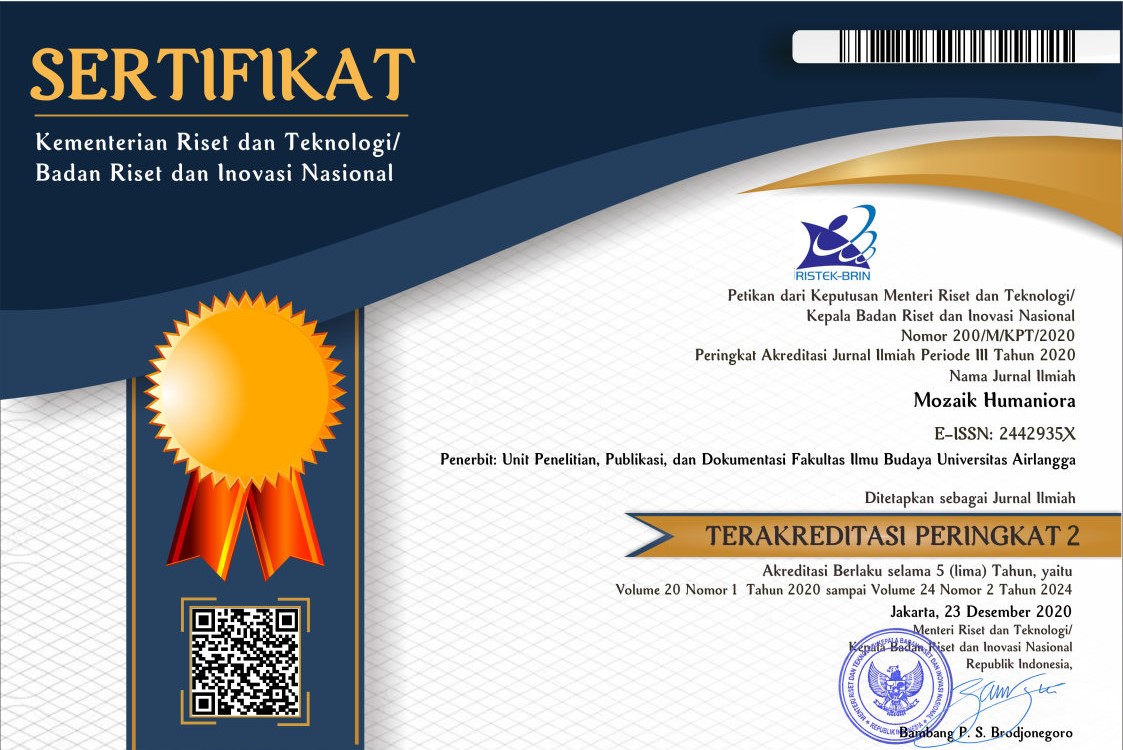Translation Techniques of Islamic Terminology in CM Hizboel Wathony's Musibah adalah Anugerah (A Blessing in Disguise)
Downloads
This study aims to identify translation techniques used in translating Islamic and tawheed terminology in the book entitled Musibah adalah Anugerah (A Blessing in Disguise) by Syech Maulana Hizboel Wathony Ibrahim. This study is an annotated translation from L1 to L2. Annotated translation is a translation supported by annotations or the translator's commentary on the chosen equivalents. To pursue the aim of this study, qualitative method is used together with library research design. This study then finds out that the translation of Islamic and tawheed terminology presents an array of translation problems. One of the problems is that there is no direct equivalent properly conveying the meaning stated in the ST (source text). For that reason, substantial schematic knowledge is required in order to fully grasp the ST and to choose the most accurate equivalent. In addition, a thorough understanding in regard to translation technique is also vital in order to select an accurate equivalent properly. Some techniques often used are transposition, modulation, generalization, couplet, and triplet. However, modulation translation technique is mostly used in translating Islamic and tawheed terminology in the book entitled Musibah adalah Anugerah (A Blessing in Disguise).
Hoed, B. H. 2006. Penerjemahan dan Kebudayaan. Jakarta: Pustaka Jaya.
Investopedia. 2021. "Zakat.” https://www.investopedia.com/terms/z/zakat.asp.
Ismail, Nursyahiirah. 2019. "The Ultimate Travel Guide for Muslims.” https://muslim.sg/articles/the-ultimate-travel-guide-for-muslims.
Koskinen, V. 2010. "An Annotated Translation of Passages from a Historical Novel by Juha-Pekka Koskinen.” Tesis. Jyväskylä: University of Jyväskylä.
Molina, L. & A. H. Albir. 2002. "Translation Techniques Revisited: A Dynamic and Functionalist Approach.” Meta 47 (4): 498”512.
Muslim Hands. 2021. "The Rules for Calculating and Paying Your Zakat.” https://muslimhands.org.uk/latest/2019/05/the-rules-for-calculating-and-paying-your-zakat.
Newmark, P. 1988. A Textbook of Translation. London: Prentice Hall.
Piroth, A. 2015. "Translation Into Non-Native Tongue.” https://www.iapti.org/files/surveys/2/IAPTI_non-native_report.pdf.
Pokorn, N. 2005. Challenging the Traditional Axioms: Translation into a Nonmother Tongue
Pym, A. 2010. Exploring Translation Theories. New York: Routledge.
Shi, H. 2017. "Annotated English Translation of KumÄrajÄ«va's XiaÅpÄnPrajñÄpÄramitÄ SÅ«tra or the Perfection of Wisdom in Eight Thousand Lines.” Asian Literature and Translation 4 (1): 187”236. DOI: https://DOI.org/10.18573/alt.26.
Sufi Terminology. http://www.almirajsuficentre.org.au/qamus/.
Thelen, M. 2005. "Translating into English as a Non-Native Language: A Dutch Connection.” Dalam In and Out of English: For Better, For Worse?, distunting oleh G. Anderman & M. Rogers. Clevedon: Multilingual Matters.
Wikipedia. "Sharia.” https://en.wikipedia.org/wiki/Sharia.
Williams, J. & A. Chesterman. 2002. The Map: A Beginner's Guide Doing Research in Translation Studies. Manchester: St. Jerome Publishing.
Copyright (c) 2022 Mediyani Budiyanto

This work is licensed under a Creative Commons Attribution-ShareAlike 4.0 International License.

Mozaik Humaniora is licensed under a Creative Commons Attribution-ShareAlike 4.0 International License. Both authors and Mozaik Humaniora agree with the following attribution of journal:
1. Copyright of this journal is possession of Author, by the knowledge of the Editorial Board and Journal Manager, while the moral right of the publication belongs to the author.
2. The journal allows the author(s) to retain publishing rights without restrictions
3. The legal formal aspect of journal publication accessibility refers to Creative Commons Attribution Share-Alike (CC BY-SA).
4. The Creative Commons Attribution Share-Alike (CC BY-SA) license allows re-distribution and re-use of a licensed work on the conditions that the creator is appropriately credited and that any derivative work is made available under "the same, similar or a compatible license”. Other than the conditions mentioned above, the editorial board is not responsible for copyright violation.


















